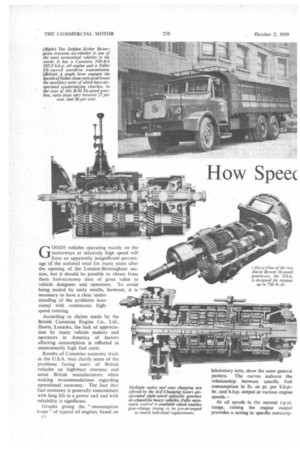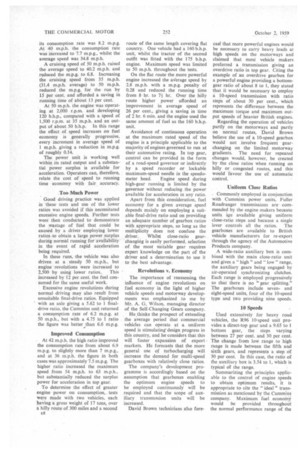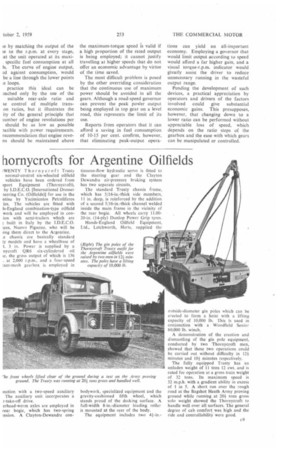How Spee(
Page 88

Page 89

Page 90

Page 91

If you've noticed an error in this article please click here to report it so we can fix it.
Teets Fuel Consumption
By P. A. C. Brockington,
A.M.I.Mech.E.
GOODS vehicles operating mainly on the motorways at relatively high speed will form an apparently insignificant percentage of the national total for many years after the opening of the London-Birmingham section, but it should be possible to obtain from them fuel-economy data of great value to vehicle designers and. operators. To avoid being misled by early results, however, it is necessary to have a clear under
standing of the problems asso ciated with continuous high speed running.
According to claims made by the British Cummins Engine Co., Ltd., Shotts, Lanarks, the lack of appreciation by many vehicle makers and operators in America of factors affecting consumption is reflected in unnecessarily high fuel costs.
Results of Cummins economy trials in the U.S.A. may clarify some of the problems facing users of British vehicles on highways overseas and assist British manufacturers when making recommendations regarding operational economy. The fact that fuel economy is generally concomitant with long life in a power unit and with reliability is significant.
Graphs giving the consumption loops" of typical oil engines, based on laboratory tests, show the same general pattern. The curves indicate the relationship between specific fuel consumption in lb. or pt. per b.h.p.hr. and b.h.p. output at various engine speeds. • At all speeds in the normal r.p.m. range, raising the engine output provides a saving in specific consump up to a critical horse-power. ier outputs result in a rapid ..ase in consumption, which is en by the loops in the curves. The of increase is greater for a given e-power increment at lower engine ds.
)1example, the Cummins JT-6 ocharged engine has a minimum ,umption rate at 1,000 r.p.m. of lb./b.h.p.-hr., which corresponds an output of about 42 b.h.p. ,ing the b.h.p. to 67, which is the imurn output at this speed, eases the consumption to 0.45 lb./ ).-hr.
comparable consumption is also tided by the unit at 2,000 r.p.m. n developing the same power, at the minimum consumption eated by the 2,000 r.p.m. curve ittle more than 0.4 lb,/b,h.p.-hr., eh is obtained when the b.h.p. is eased to 120.
igher outputs at 2,000 r.p.m. ease the consumption a relatively 11 amount and a rate of about 5 lb./b.h.p.-hr. is returned by the at the maximum output of
-oximately 155 b.h.p. The unit :lops its peak output of 175 b.h.p. ,500 r.p.m. and the optimum con
sumption at this speed, obtained when the output is 160 b.h.p., is also about 0.425 lb./b.h.p.-hr.
Maximum torque of Cummins engines is produced at a relatively high speed compared with the majority of British oil engines, a torque of 407 lb.-ft. being produced by the JT-6 engine at 1,750 r.p.m. As a result, maximum economy is provided at higher engine speeds.
Although the most favourable consumption is obtained at 1,000 r.p.m., it represents a negligible gain compared with the optimum rate yielded at 2,000 r.p.m. Because consumption at the lower speed is extremely sensitive to small increases in output, the consumption of the engine in the region of 2,000 r.p.m. may be regarded in practice as the optimum fuel rate.
The rated minimum consumption of all tengines is derived from records of laboratory tests at maximum output, and the speed at which it is obtained is not necessarily indicative of the r.p.m. most favourable to economy at all outputs,
• An analysis of the Cummins consumption loops emphasizes the accepted dictum that an oil engine should operate at revolutions above the speed at which maximum torque is developed and, of greater importance, appreciably below the maximum rated speed. Cummins technicians state that, ideally, the normally aspirated and turbocharged units produced by the concern should operate at speeds within 20 per cent. of the rated speed. In the case of engines developing maximum torque at substantially lower revolutions than the Cummins units, this economy range would be extended.
The recommendation to operate in this range applies only to a laden vehicle which, of necessity, has to run
at cruising speeds requiring a substantial proportion of the rated power output. In America this speed is around 50 m.p.h., which is the legal limit on many of the highways. Wind resistance increases as the square of road speed, and lower speeds normally yield an Improved consumption despite a reduction in engine speed below the nominal optimum.
The 100-mile route selected for the Cummins tests included about 15 per cent, of urban streets and was across rolling country with some hilly sections, whichwas regarded as typical of the main routes in America, Most of the tests were performed with a Kenworth-Fruehauf semi-trailer outfit, the tractor of which was powered by a Cummins JT-6 engine, and the vehicle was loaded to give a gross weight in one case of 17 tons and in the other of approximately 211 tans.
Operating with the heavier load at a cruising speed of .30 m.p.h. the vehicle averaged nearly 28 m.p.h. and its consumption rate was 8.2 m.p.g. At 40 m.p.h. the consumption rate was increased to 7.7 m.p.g., whilst the average speed was 34.8 m.p.h.
A cruising speed of 50 m.p.h. raised the average speed to 40.2 m.p.h. and reduced the m.p.g. to 6.8. Increasing the cruising speed from 35 m.p.h. (31.4 m.p.h. average) to 50 m.p.h. reduced the m.p.g. for the run by 15 per cent. and afforded a saving in running time of about 13 per cent.
At 50 m.p.h. the engine was operating at 2,000 r.p.m. and developing 120 b.h.p., compared with a speed of 1,500 r.p.m. at 35 m.p.h. and an output of about 50 b.h.p. In this range the effect of speed increases on fuel economy is generally progressive, every increment in average speed of 1 m.p.h. giving a reduction in m.p.g. of roughly 0.14.
The power unit is working well within its rated output and a substantial power surplus is available for acceleration. Operators can, therefore, relate the cost of speed to running time economy with fair accuracy.
Too Much Power
Good driving practice was applied in these tests and use of the lower ratios was avoided if this necessitated excessive engine speeds. Further tests were then conducted to demonstrate the wastage of fuel that could be caused by a driver employing lower ratios.to obtain a large power surplus during normal running for availability in the event of rapid acceleration being required.
In these runs, the vehicle was also driven at a steady 50 m.p.h., but engine revolutions were increased to 2,500 by using lower ratios. This increased by 12 per cent. the fuel consumed for the same useful work.
Excessive engine revolutions during normal driving may also result from unsuitable final-drive ratios. Equipped with an axle giving a 5.62 to 1 finaldrive ratio, the Cummins unit returned a consumption rate of 6.2 m.p.g. at 50 m.p.h., but with a 4.75 to 1 ratio the figure was better than 6.6 m.p.g.
Improved Consumption
At 42 m.p.h. the high ratio improved the consumption rate from about 6.9 m.p.g. to slightly more than 7 m.p.g., and at 36 m.p.h. the figure in both cases was approximately 7.5 m.p.g. The higher ratio increased the maximum speed from 54 m.p.h. to 63 m.p.h., but substantially reduced the surplus power for acceleration in top gear.
To determine the effect of greater engine power on consumption,, tests were made with two vehicles, each having a gross weight of 17 tons, over a hilly route of 300 miles and a second
E8 route of the same length covering flat country. One vehicle had a 160 b.h.p. unit, whilst the tractor of the second outfit was fitted with the 175 b.h.p. engine. Maximum speed was limited to 50 m.p.h. throughout the tests.
On the flat route the more powerful engine increased the aVerage speed by 2.8 m.p.h. with a m.p.g. penalty of 028 and reduced the running time from 8 hr. to 71 hr. Over the hilly route higher power afforded an improvement in average speed of 26 per cent., giving a saving in time of 2 hr. 6 min. and the engine used the same amount of fuel as the 160 b.h.p. unit.
Avoidance of continuous operation at the maximum rated speed of the engine is a principle applicable to the majority of engines governed to run at their automotive rating. In top gear, control can be provided in the form of a road-speed governor or indirectly by a speed recorder or lockable maximum-speed needle in the speedo
meter head. Engine speed during high-gear running is limited by the governor without reducing the power available for acceleration in any ratio.
Apart from this consideration, fuel economy for a given average speed depends mainly on employing a suitable final-drive ratio and on providing an adequate number of gearbox ratios with appropriate steps, so long as the multiplicity does not confuse the driver. Whilst close-ratio gearchanging is easily performed, selection of the most suitable gear requires expert knowledge on the part of the driver and a determination to use it to the best advantage.
Revolutions v. Economy
The importance of reassessing the influence of engine revolutions on
fuel economy in the light of higher vehicle speeds and motorway developments was emphasized to me by Mr. A. G, Wilson, managing director of the Self-Changing Gears company.
He,thinks the prospect of extending the average period that commercial vehicles can operate at a uniform speed is stimulating design progress in this country, and he-considers that this will foster expansion of export markets. He forecasts that the more general use of turbocharging will increase the demand for multi-speed gearboxes with relatively close ratios.
The company's development programme is accordingly based on the assumption that gearboxes enabling the optimum engine speeds to be employed continuously will be required and that the scope of auxiliary transmission units will be increased.
David Brown technicians also fore
casi that more powerful engines would be necessary to carry heavy loads at high speeds on the motorways and claimed that most vehicle makers preferred a transmission giving an overdrive ratio in top gear. Citing the example of an overdrive gearbox for a powerful engine providing a bottomgear ratio of about 8 to 1, they stated that it would be necessary to employ a 10-speed transmission with ratio steps of about 30 per cent., which represents the difference between the maximum torque and maximum output speeds of heavier British engines.
Regarding the operation of vehicles partly on the motorways and partly on normal routes, David Brown believe the use of a 10-speed gearbox would not involve frequent gearchanging on the limited motorway gradients. The need for repeated changes would, however, be created by the close ratios when running on hilly or congested routes, and this would favour the use of automatic control.
Uniform Close Ratios
Commonly employed in conjunction with Cummins power units, Fuller Roadranger transmissions are commended by the engine makers because units are available giving uniform close-ratio steps and because a single lever controls all the ratios. The gearboxes are available to British vehicle manufacturers for re-export through the agency of the Automotive Products company.
A wide-ratio auxiliary box is combined with the main close-ratio unit and gives a " high " and " low " range, the auxiliary gears being engaged by air-operated synchronizing clutches. Each range is employed progressively so that there is no "gear splitting." The gearboxes include sevenand eight-speed units, four of the 10-speed type and two providing nine speeds.
10 Speeds
Used extensively for heavy road vehicles, the R96 10-speed unit provides a direct-top gear and a 9.65 to 1 bottom gear, the steps varying between 27 per cent. and 30 per cent. The change from tow range to high range is made between the fifth and sixth gears, and represents a step Of 30 per cent. In this case, the ratio of the auxiliary box is 3.54 to 1, which is typical Of the range.
Summarizing the principles applicable to the control of engine speeds to obtain optimum results, it is appropriate to cite the " ideal" transmission as mentioned by the Cummins company. Maximum fuel economy, would be provided throughout the normal performance range of the le by matching the output of the le to the r.p.m. at every stage, at the unit operated at its maxispecific fuel consumption at all Is. The curve of engine output, cd against consumption, would be a line through the lower points Le loops.
practice this ideal can be Dached only by the use of the suitable rear-axle ratio and se control of multiple transon ratios, but it illustrates the ity of the general principle that lumber of engine revolutions per should be as low as possible 3atible with power requirements. recommendation that engine revons should be maintained above the maximum-torque speed is valid if a high proportion of the rated output is being employed; it cannot justify travelling at higher speeds that do not offer an economic advantage by virtue of the time saved.
The most difficult problem is posed by the other overriding consideration that the continuous use of maximum power should be avoided in all the gears. Although a road-speed governor can prevent the peak poWer output being employed in top gear on a level road, this represents the limit of its use.
Reports from operators that it can afford a saving in fuel consumption of 10-15 per cent. confirm, however, that eliminating peak-output opera
tions can yield an all-important economy. Employing a governor that would limit output according to speed would afford a far higher gain, and a visual torque-r.p.m. indicator would gieatly assist the driver to reduce unnecessary running in the wasteful output range.
Pending the development of such devices, a practical appreciation by operators and drivers of the -factors involved could give substantial economic gains. This presupposes, however, that changing down to a lower ratio can be performed without appreciable loss of speed, which depends on the ratio steps of the gearbox and the ease with which gears can be manipulated or controlled.












































































































































































































































